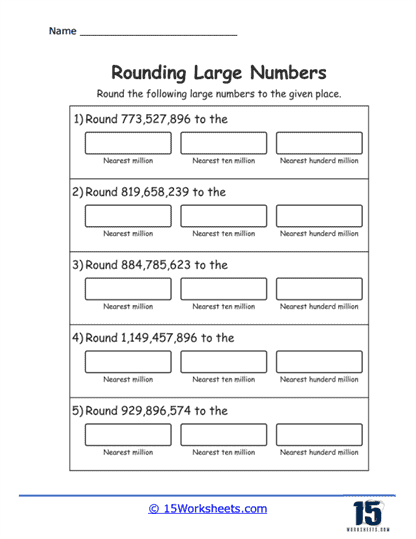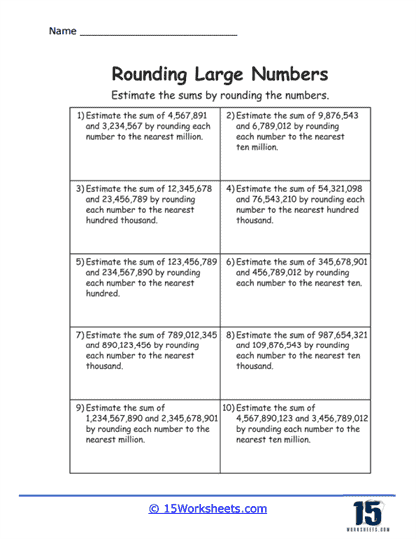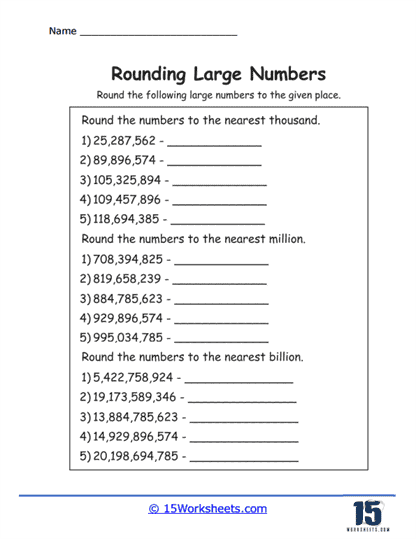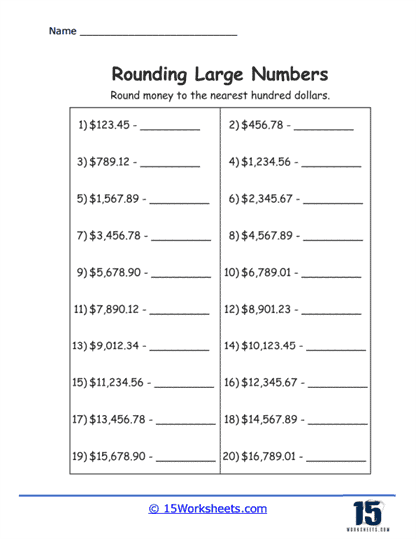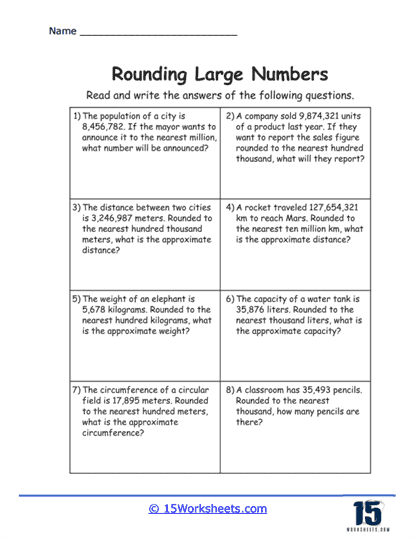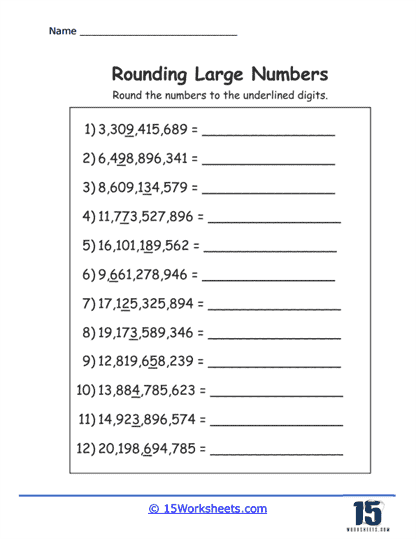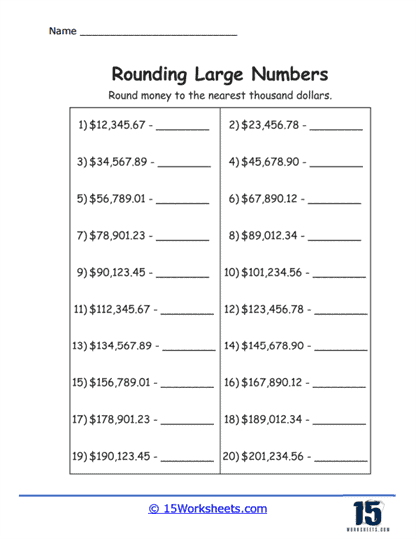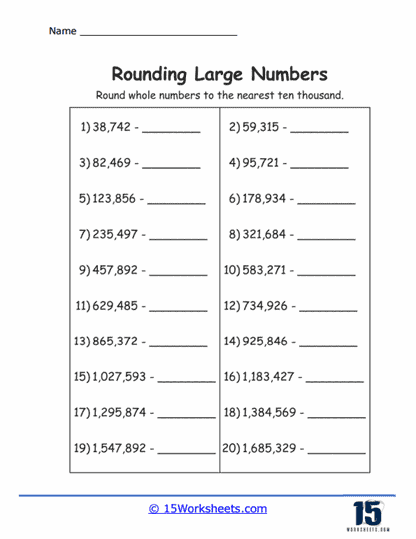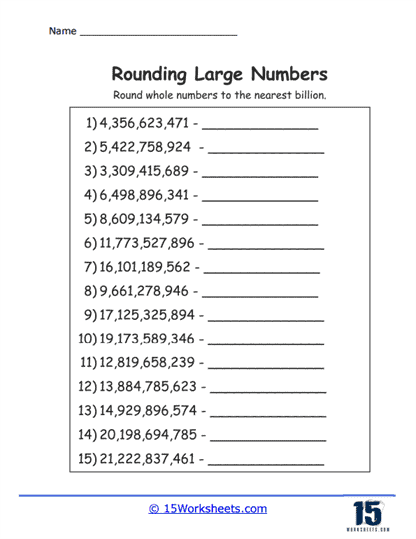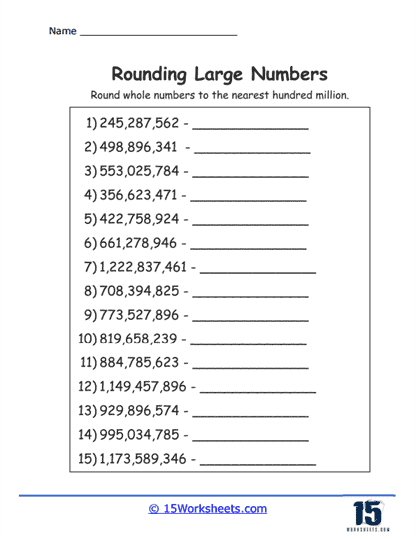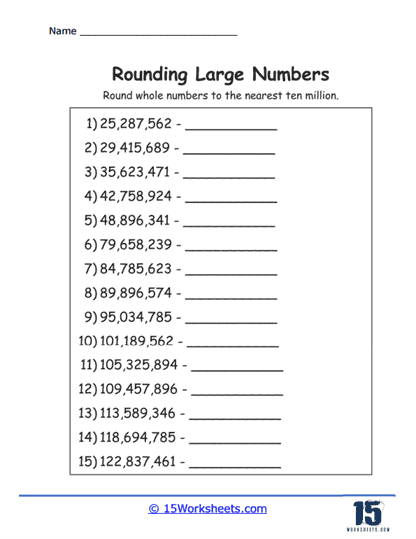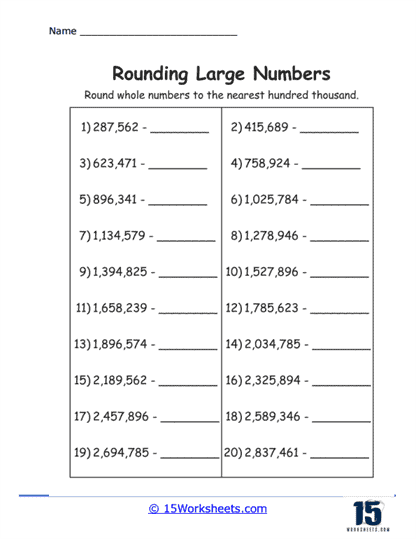Rounding Large Numbers Worksheets
About These 15 Worksheets
These worksheets will help students master the skill of estimating and simplifying large numbers. These worksheets focus on a variety of rounding tasks, from rounding whole numbers to the nearest thousand, million, or even billion, to rounding money and applying these skills in real-world scenarios. By using these worksheets, students can improve their understanding of place value, enhance their number sense, and become more comfortable with large numbers, which are often encountered in advanced math and everyday life.
One of the primary types of tasks you will find in these worksheets is rounding whole numbers to the nearest ten thousand, hundred thousand, million, or even ten million. For example, students might be asked to round numbers like 38,742 to the nearest ten thousand or 29,415,689 to the nearest ten million. These exercises teach students how to identify which digit in a large number determines the rounding, based on the place value being rounded to. They also learn how to decide whether to round up or down, depending on the value of the digits that follow. This practice is crucial in building a strong foundation in understanding large numbers and how they behave in different rounding scenarios.
Another common type of exercise involves rounding monetary amounts to the nearest hundred dollars. These worksheets present students with monetary values, often with decimals, and ask them to round these amounts to the nearest hundred. For example, students might need to round $123.45 or $7,890.12 to the nearest hundred dollars. This type of task is especially useful because it directly relates to real-world applications, such as budgeting or financial planning. By rounding monetary values, students learn how to approximate costs and amounts in a practical way, which is an invaluable skill in managing finances.
This series of worksheets also includes word problems that incorporate rounding into everyday scenarios. These problems might ask students to round the population of a city to the nearest million or the distance between two cities to the nearest hundred thousand meters. By engaging with these word problems, students not only practice their rounding skills but also learn how to apply these skills in contexts that they might encounter outside of the classroom. This type of problem-solving reinforces the importance of rounding in making estimates and decisions in daily life.
Some worksheets use true or false questions to assess students’ understanding of rounding concepts. For instance, students might be asked whether rounding 45,678 to the nearest thousand gives 45,000 or whether rounding 123,456,789 to the nearest million gives 124,000,000. These true or false questions challenge students to think critically about the rounding process and verify their understanding of how rounding changes a number. It’s a great way to reinforce the concepts taught and to ensure that students aren’t just memorizing rules but are actually comprehending the logic behind rounding.
Another valuable exercise in these worksheets involves rounding numbers to specific underlined digits. In this task, students are given large numbers with certain digits underlined, and they are asked to round the entire number to the place value of the underlined digit. For example, if the number is 3,309,415,689 with the digit 4 underlined, students must round the number to the nearest hundred thousand. This exercise sharpens students’ focus on specific place values within a number, helping them to pinpoint exactly where and how rounding affects a number. It also helps them to develop precision in their rounding, which is critical for accurate estimation.
Some worksheets include more complex rounding tasks where students must round numbers to multiple place values within the same exercise. For instance, a problem might ask students to round the number 773,527,896 to the nearest million, ten million, and hundred million all within one task. This type of exercise deepens students’ understanding of how rounding to different place values impacts a number and encourages them to think flexibly about rounding. It’s an excellent way to build students’ confidence in handling large numbers and ensures that they are comfortable rounding numbers in various contexts.
This set of worksheets may require students to round numbers to the nearest thousand, million, or even billion within the same exercise. This type of practice is particularly beneficial for students who are preparing for more advanced math topics, such as algebra or statistics, where large numbers and rounding are common. By rounding to such large place values, students gain experience in managing extremely large numbers, which can be intimidating without the proper foundation. It also teaches them the importance of accuracy in estimation, especially when dealing with data on a grand scale, such as in scientific or financial contexts.
Whether rounding to the nearest thousand, million, or billion, working with monetary values, solving word problems, or verifying true or false statements, these worksheets cover all the essential skills needed to master rounding. By engaging with these tasks, students build a strong foundation in number sense, place value, and estimation, all of which are crucial for success in advanced mathematics and real-world applications.

